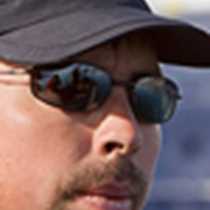Hornsund, Spitsbergen
We entered Hornsund on a beautiful Saturday morning. Hornsund is situated in the south-west national park. It is the southernmost fjord on Spitsbergen - that is the biggest island in the archipelago of Svalbard. We did a landing at Gnålodden - the name meaning "whining point". The name is easily understood, seeing and especially hearing the thousands of Kittiwakes and Brunnichs guillemots nesting on the cliff. The Kittiwakes were still building nests, as we could see them flying down from the birdcliff to the tundra, taking mosses in their bills, soaking this in the water on a nearby lake and transporting this up to the nests.
At this beautiful place there is also an old Norwegian trapper-hut. Hornsund is known for its great amounts of polar bears, which made this area attractive to hunters. One of the most famous female trappers - Wanny Woldstad, was a trapper here for many years and also used the trappers hut at Gnålodden. Walking further on along the beach we also found a gravesite together with remnants of an old Pomor-hut. The origin of the gravesite is unknown, and it could be in connection with the Pomor-hut or maybe from the active whaling period that was going on here from 1600-1700.
The Pomor-hut however, we know some more about. The name "Pomor" means "by the sea", and indicates that this was a tribe that came from the White sea in Russia. Pomor-huts are easily recognized by the distinct way they are built, where the huts were prefabricated in Russia with four corner-logs that have a slit. After setting up the corners they just slided planks down in the slit on corners and this made the walls. This hut was erected in the 18th century, and had a crew of 8-10 people. The Pomor trapping however ended in the 1850's, due to ineffective hunt and probably political reasons within Russia.
After visiting this beautiful bird cliff we explored along the coastline in the ship, and as we went into a fiord called Brepollen, we spotted the first polar bear. A short time after, we spotted two more polar bears, and they were all walking on the fast ice inside the fiord. We went as close as the thick ice would allow us, and spent some time looking at these beautiful animals. As the clock approached to 19.00, we turned the ship around and went to the captain's cocktail party, with high hopes for more polar bears in the pack ice tomorrow...
We entered Hornsund on a beautiful Saturday morning. Hornsund is situated in the south-west national park. It is the southernmost fjord on Spitsbergen - that is the biggest island in the archipelago of Svalbard. We did a landing at Gnålodden - the name meaning "whining point". The name is easily understood, seeing and especially hearing the thousands of Kittiwakes and Brunnichs guillemots nesting on the cliff. The Kittiwakes were still building nests, as we could see them flying down from the birdcliff to the tundra, taking mosses in their bills, soaking this in the water on a nearby lake and transporting this up to the nests.
At this beautiful place there is also an old Norwegian trapper-hut. Hornsund is known for its great amounts of polar bears, which made this area attractive to hunters. One of the most famous female trappers - Wanny Woldstad, was a trapper here for many years and also used the trappers hut at Gnålodden. Walking further on along the beach we also found a gravesite together with remnants of an old Pomor-hut. The origin of the gravesite is unknown, and it could be in connection with the Pomor-hut or maybe from the active whaling period that was going on here from 1600-1700.
The Pomor-hut however, we know some more about. The name "Pomor" means "by the sea", and indicates that this was a tribe that came from the White sea in Russia. Pomor-huts are easily recognized by the distinct way they are built, where the huts were prefabricated in Russia with four corner-logs that have a slit. After setting up the corners they just slided planks down in the slit on corners and this made the walls. This hut was erected in the 18th century, and had a crew of 8-10 people. The Pomor trapping however ended in the 1850's, due to ineffective hunt and probably political reasons within Russia.
After visiting this beautiful bird cliff we explored along the coastline in the ship, and as we went into a fiord called Brepollen, we spotted the first polar bear. A short time after, we spotted two more polar bears, and they were all walking on the fast ice inside the fiord. We went as close as the thick ice would allow us, and spent some time looking at these beautiful animals. As the clock approached to 19.00, we turned the ship around and went to the captain's cocktail party, with high hopes for more polar bears in the pack ice tomorrow...




